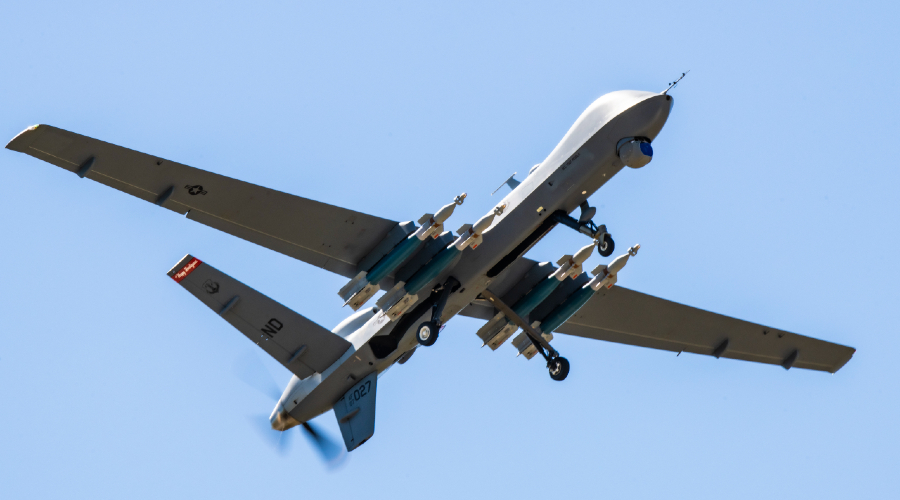Finding the Appropriate Balance of Risk in Over-the-Horizon Strikes
Now that Afghanistan is no longer an area of active hostilities, strikes should be subject to the standard of near certainty.

Published by The Lawfare Institute
in Cooperation With

Editor’s Note: The killing of 10 civilians, including seven children, in a drone strike intended to target Islamic State in Khorasan province operatives was a depressing punctuation to the messy U.S. exit from Afghanistan. Although most Americans are happy to say farewell to Afghanistan, drone strikes and other counterterrorism operations will continue as long as the United States perceives a threat from terrorist groups there. Brian Hausle and Matt Montazzoli, both active-duty officers who had responsibilities for counterterrorism in Afghanistan, argue that the United States should continue operations but raise the standard for strikes to “near certainty,” requiring more information before acting and otherwise reducing the likelihood of deadly mistakes.
Daniel Byman
***
On the evening of Aug. 26, a suicide bomber attacked the crowded entrance to Kabul’s Hamid Karzai International Airport, killing 13 U.S. service members and scores of Afghan civilians. NATO forces continued evacuation operations while, hundreds of miles away, U.S. Central Command’s “over-the-horizon strike cell” began an intense effort to interdict additional attacks. U.S. analysts in the strike cell believed they identified individuals planning another attack against the airport based on “threat streams indicating imminent attacks that looked similar to the attack that happened three days prior.” The strike cell employed a drone-delivered missile to destroy a suspected car bomb in downtown Kabul. As exhaustive New York Times reporting quickly revealed, the military later admitted, and an investigation eventually concluded, the car belonged to a U.S.-employed aid worker with no connection to any impending attack. The strike killed 10 civilians, including seven children.
The United States must learn from this tragedy, but there is grave risk in overlearning the lessons of that Aug. 29 strike. Imposing policy constraints or inflexible processes that unduly restrict over-the-horizon counterterrorism efforts may deny practitioners the tools to prevent extremist attacks outside Afghanistan. The best way to balance the risks inherent in a lethal, over-the-horizon counterterrorism campaign is to set a standard of “near certainty” for both target identification and protection of civilians. This elevated standard allows the United States to act against extremist networks while reducing the risk of catastrophic errors.
Over-the-Horizon Operations
The Biden administration’s view of the vital U.S. interest in Afghanistan is clear: The United States must maintain the ability to monitor and act against terrorists “to make sure Afghanistan can never be used again to launch an attack on our homeland.” Furthermore, the administration has affirmed that it intends to “maintain the fight against terrorism in Afghanistan from over the horizon—just as [the United States] will do in other countries across the world.” Indeed, the U.S. pivot to prioritizing strategic competition with powerful states rests on the assumption that lingering terror threats can be mitigated without U.S. troops in Afghanistan. Whether this counterterrorism policy is designed to disrupt terrorist safe havens or decapitate extremist leadership, lethal strikes will be a central feature.
Acknowledging that the pressure to avoid errors like the Aug. 29 strike will remain immense, a near certainty standard for target identification and the safeguarding of civilians allows policymakers to avoid undue hesitation when authorizing future operations. Historical examples like Afghanistan during the 1990s and Iraq during the 2010s demonstrate the costs of excessive risk aversion and illustrate why continued pressure in the form of lethal strikes may be the least bad option for U.S. counterterrorism in Afghanistan.
Historical Lessons and Warnings
Pre-9/11 counterterrorism efforts furnish a cautionary tale about the limits of over-the-horizon operations. During the 1980s and 1990s, the U.S. military’s role in counterterrorism was limited mostly to employing traditional military power to punish state sponsors of terrorism. Examples include a 1986 series of airstrikes against Libya and a 1993 cruise missile strike against Iraq. The 9/11 Commission observed that the U.S. Defense Department’s concept of counterterrorism in these years focused on “limited retaliation with air power, aimed at deterrence. What remained was the hard question of how deterrence could be effective when the adversary was a loose transnational network.”
By the late 1990s, Osama bin Laden had relocated the core of his loose, transnational terrorist network to Afghanistan and made clear his desire to strike the United States through word and deed. In response to the 1998 East Africa embassy bombings, President Clinton ordered cruise missile strikes against a suspected chemical weapons facility in Sudan and al-Qaeda camps in Afghanistan, but the group’s leadership was unscathed. A plan for “an ongoing campaign of strikes against bin Laden’s bases in Afghanistan” was shelved as overly aggressive, and a covert action program to employ local surrogates to “mark his location and call in another round of missile strikes” was abandoned over concerns about target fidelity and the risk to civilians. It is not our purpose to relitigate this risk calculus, but to highlight the potential costs of repeating similar mistakes today, keeping in mind that the tepid U.S. over-the-horizon campaign to disrupt bin Laden’s safe haven was one aspect among a litany of interagency failures that culminated in al-Qaeda’s 9/11 attack.
The U.S. withdrawal from Iraq in 2011 showed how quickly terrorism can draw U.S. forces back into conflict zones. Unlike the chaotic evacuation from Kabul, the deliberate U.S. drawdown in Iraq left behind a robust diplomatic mission and sizable security forces that still benefited from U.S. and partner-nation support. Nonetheless, in just a few years an ostensibly neutralized al-Qaeda subsidiary metastasized into the Islamic State. The group seized vast swaths of territory and conducted terrorist attacks far outside the Middle East. In 2014, the United States formed a multinational coalition and deployed thousands of troops to defeat the Islamic State. That mission continues today.
Post-withdrawal counterterrorism in Afghanistan will be much more difficult than in Iraq. There is no friendly government partner, no nearby military bases and the rugged terrain favors violent groups seeking refuge, including the Islamic State’s regional affiliate, the Islamic State in Khorasan province (IS-K), and vestiges of al-Qaeda. Afghanistan today possesses an international airport and telecommunications infrastructure—significant advantages for extremists seeking to project violence abroad. The Taliban show no signs of severing ties with al-Qaeda. Even if the Taliban government were inclined to become a reliable counterterrorism partner, it is not clear that the new regime has the capability to disrupt IS-K or exercise sovereignty over all of Afghanistan. In these ungoverned spaces are the potential seeds of the next attack on the United States and a clear danger of rekindling the generational conflict the withdrawal intended to escape.
Shortcomings of Over-the-Horizon Operations
The Aug. 29 strike should temper expectations for over-the-horizon counterterrorism precisely because the botched strike was not a rushed affair but what the U.S. military previously characterized as an example of meticulous targeting. It reportedly involved half a dozen drones and layered sources of intelligence. U.S. Central Command Commander Gen. Frank McKenzie pointed out that “[t]he strike cell deliberately followed and observed this vehicle and its occupants for eight hours while crosschecking what they were seeing with all available intelligence to develop a reasonable certainty of the imminent threat that this vehicle posed to our forces.” Although the defense of U.S. troops and civilians at the airport added urgency, the confirmation bias, target identification errors and tragic outcome illustrate the hazards inherent with over-the-horizon strikes.
Strike operations from over the horizon suffer from longer transit times and shorter loiter windows, and may lack the benefit of timely human intelligence for both targeting and poststrike assessment. This makes them less efficient and often less effective, and it engenders greater risk to noncombatants. Still, applied with the right threshold of certainty, this approach is the least bad option available—a sustainable method for disrupting extremists without the costs of deploying ground forces or the pitfalls of covert action.
According to reports, on Aug. 29 “[t]he rules of engagement allowed the military to conduct a strike if the operators and intelligence analysts had ‘reasonable certainty’ that they had a legitimate ISIS target and assessed there was a ‘reasonable certainty’ that no noncombatant civilians, including women and children, would be killed or injured.” This “reasonable certainty” standard is lower than the near certainty threshold required for drone strikes outside of “areas of active hostilities” in previously declassified U.S. government counterterrorism policy guidance. These certainty standards are policy constructs and not legal terms of art. Analogizing to common legal standards may be helpful in understanding the distinction between near certainty and reasonable certainty, but it is important to note that available sources do not define (nor quantify) the standards. It is critical to avoid conflating legal obligations with policy choices.
Reasonable certainty must at least satisfy the international law requirement for “good faith” in targeting, along with “feasible precautions” to protect civilians from harm due to otherwise lawful attacks. It is roughly analogous to the probable cause standard familiar from criminal procedure. Probable cause is satisfied where the known facts and circumstances are sufficient to convince a person of “reasonable prudence”—in other words, reasonable certainty.
Near certainty is analogous to “beyond a reasonable doubt,” the standard for conviction of a crime. This requirement for “proof to an evidentiary certainty, although not necessarily to an absolute or mathematical certainty” makes intuitive sense when analyzing life-and-death decisions, but is emphatically not what the law of war requires to satisfy the standard for good faith in targeting. With American lives at stake in Kabul and U.S. forces engaged in operations on the ground, the reasonable certainty threshold was appropriate. Now, defining an appropriate threshold of certainty for future strikes is key to preserving lethal counterterrorism operations as a feasible and acceptable policy.
Accepting Near Certainty
Given that active hostilities in Afghanistan have ended, policymakers would do well to impose the near certainty threshold on lethal operations in that country, assuming the jus ad bellum concerns surrounding such strikes are satisfied. The near certainty standard should apply to both targeting and safeguarding of civilians—meaning a commander must be near certain a target is a lawful military objective and also near certain that an attack will not harm any civilians or civilian objects. If a commander believes the high value of a target justifies deviation from the near certainty standard, there is a process for review and approval via the military chain of command through the geographic combatant commander and secretary of defense, culminating in a presidential decision if the circumstances require. The near certainty standard provides an appropriate balance among disrupting extremist groups, protecting civilians, and preserving U.S. credibility and freedom of action.
The ongoing U.S. effort to disrupt extremists in the Horn of Africa offers a useful model of over-the-horizon counterterrorism with an elevated standard for target identification and civilian protection. U.S. forces have judiciously employed surveillance and strikes to degrade terrorist networks and limit their projection of violence. Leaders have publicly described the standard in that theater as “a very, very high degree of certainty” for target identification and civilian protection, suggesting that they operate under the near certainty standard. With fewer and smaller scale incidents of harm to civilians, the long-running operation against al-Shabaab has garnered comparatively little international scrutiny or domestic political pushback. Despite the persistent threat, over-the-horizon operations with a high threshold of certainty have mostly disrupted threats to U.S. interests and prevented the type of high-profile attacks that spurred large troop commitments in Afghanistan and Iraq.
Advocating for continued lethal counterterrorism operations in the wake of the Aug. 29 strike may seem like a cold, insensitive position. Shifting from reasonable to near certainty will do little to satisfy critics of U.S. counterterrorism campaigns. In the absence of realistic alternatives, though, improvements to the over-the-horizon strike framework provide the best chance to put counterterrorism operations in Afghanistan on a sustainable footing, freeing attention and resources for strategic competition.
These views are those of the authors and do not necessarily represent those of the U.S. Department of the Army or the U.S. Department of Defense.






